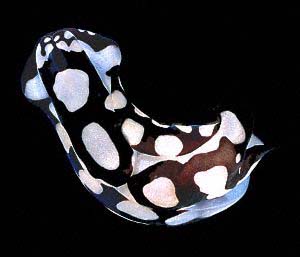
Philinopsis pilsbryi
(Eliot, 1900)
Order: CEPHALASPIDEA
Family: Aglajidae
DISTRIBUTION
Tropical Indo-West Pacific.
PHOTO
Noumea, New Caledonia. 30 mm long alive. October 1988. PHOTO: Bill Rudman.
The animal is translucent white with a pattern of black reticulate lines. In some specimens the lines are relatively thin and the the head shield pattern is essentially a black figure of eight with some smaller rings and reticulations anteriorly, and similar figure of eight, often broken, is found on the posterior shield. The upper, outer edge of the parapodia has a black reticulation and the ventral part of the parapodia and the foot are colourless. The colour pattern though is very variable and tuns through to animals which could best be described as being black dorsally with white spots. In these black variations there are usually two large white spots on the headshield and the posterior shield. In these darker forms, the colour is somewhat similar to that of some variants of P. reticulata, but in that species the black reticulation always extends across the ventral surface of the foot, and there are blue patches along the parapodial edge.
Philinopsis pilsbryi is another of the genus with a long tubular pharynx. See Philinopsis gardineri for information.
- Rudman,W.B., (1972) A comparative study of the genus Philinopsis Pease, 1860 (Aglajidae, Opisthobranchia). Pacific Science, 26: 381-399.
- Rudman,W.B., (1972) Structure and functioning of the gut in the Bullomorpha (Opisthobranchia). Journal of Natural History, 6: 547-560.
Rudman, W.B., 2007 (July 27) Philinopsis pilsbryi (Eliot, 1900). [In] Sea Slug Forum. Australian Museum, Sydney. Available from http://www.seaslugforum.net/find/philpils
Related messages
Philinopsis pilsbryi from the Solomon Islands
August 7, 2008
From: Barbara Hanchard
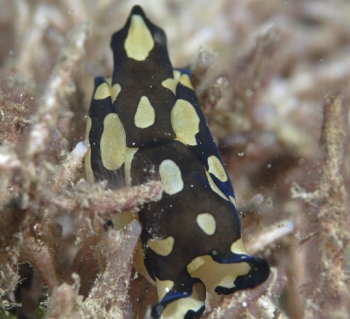
Concerning message #21586:
Hi Bill,
Also a record for Philinopsis pilsbryi recorded in the Solomon Islands for the Forum's record. This is the second time I have found this species at this site but certainly not common or in the amounts found by the entry from southern Queensland. It was certainly much larger than the first one I found. Didn't get a look at the underside/foot to double check for the absence of markings.
Locality: Leilei, Honiara, 13 meters, Solomon Islands, Pacific Ocean, 02 August 2008, Sandy slope. Length: 50 mm. Photographer: N.Barbara Hanchard.
Regards
Barbara Hanchard
barbara.hanchard@ffa.int
Hanchard, N.B., 2008 (Aug 7) Philinopsis pilsbryi from the Solomon Islands . [Message in] Sea Slug Forum. Australian Museum, Sydney. Available from http://www.seaslugforum.net/find/21766Dear Barbara,
Thanks for the record. Even without knowing the colour of the underside, the shape of the 'head' is definitely as in P. pilsbryi,
Best wishes,
Bill Rudman
Philinopsis pilsbryi found Vanuatu
June 4, 2008
From: Leanne & David Atkinson
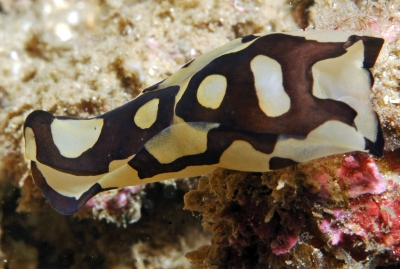
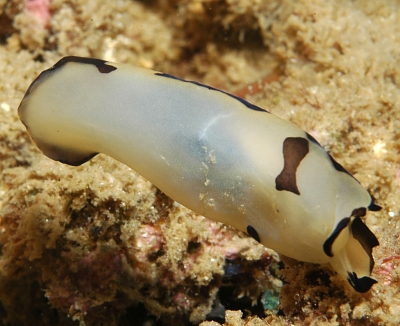
Hi Bill,
You don't have a record of Philinopsis pilsbryi from Vanuatu. We thought you might like this one to extend the range and also because of the behaviour. We saw this animal travelling along the sandy covered rocky bottom and it reached the edge of the rock/coral it was on. When the body was half way in midspace it flipped itself over to show the foot in photo 3 and then curled back up to solid ground. Consequently we got a nice shot of the foot without having to disturb the animal.
Locality: Ghost Train, Mele Reef, Hideaway Island, 8 metres, Vanuatu, Pacific, 14 April 2008, Coral Reef with gutters running through the reef with sandy silty bottom. Length: approximately 50 mm. Photographer: Leanne & David Atkinson.
Hope this is of interest.
Regards,
Leanne & David Atkinson
atk@hunterlink.net.au
Atkinson, L. & D., 2008 (Jun 4) Philinopsis pilsbryi found Vanuatu. [Message in] Sea Slug Forum. Australian Museum, Sydney. Available from http://www.seaslugforum.net/find/21586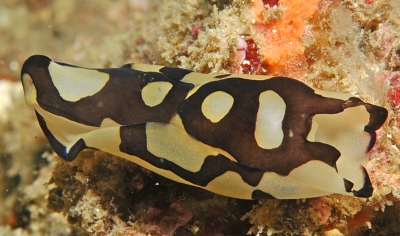
Thanks Leanne & David,
Best wishes,
Bill Rudman
Philinopsis pilsbryi found sthn Queensland
August 2, 2007
From: Gary Cobb
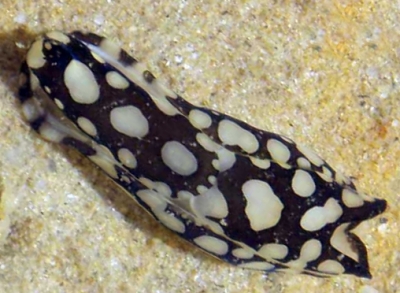
Hi Bill and everyone!
Well it was an unexpected visit to say the least. Behind my unit is a waterway that heads out to Mooloolaba and the breakwater. When I came to the water's edge I noticed what appeared to be a slug. It was then I realized it was Philinopsis pilsbryi... not one but hundreds! Including egg masses. The colour variations were incredible.
Locality: Mooloolaba Sunshine Coast, 100mm- along the shore line, Queensland, Australia, Pacific Ocean, 26 July 2007, Intertidal. Length: 20-55 mm. Photographer: Gary Cobb.
Thanks,
Gary Cobb
gary@nudibranch.com.au
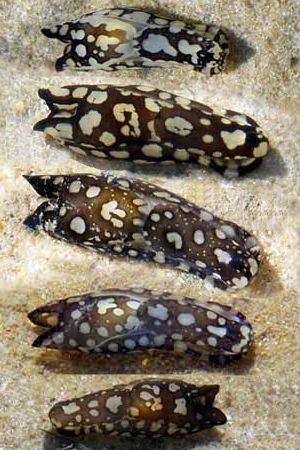
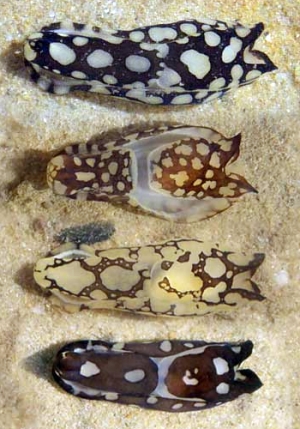
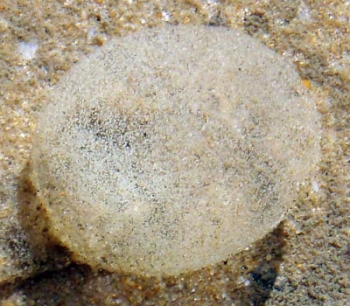
Dear Gary,
Thanks for this wonderful display of colour variation. When first saw your photo of the colour variation I wondered how you had trained them to line up so neatly, then I realised you had arranged them with a bit of digital technology, which I have also used to pack them a bit closer together.
Your message is a perfect illustration of the point I made in answering Nur Leena Wong's question [message #20323 ] about whether Chelidonura pallida was a rare or uncommon species. I have never considered P. pilsbryi to be a common species. I have found it quite often but always in ones or twos. On the other hand I have found large concentrations of other aglajids, such as Philinopsis cyanea, Chelidonura sandrana, C. fulvipunctata, C. electra, and C. inornata. Your find of P. pilsbryi in large numbers just illustrates how difficult it is to label a species as common or rare.
Best wishes,
Bill Rudman
Philinopsis pilsbryi from Milne Bay, PNG
July 18, 2007
From: Clinton Bauder
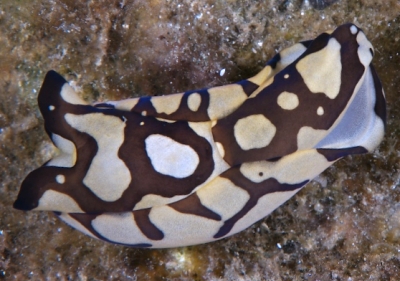
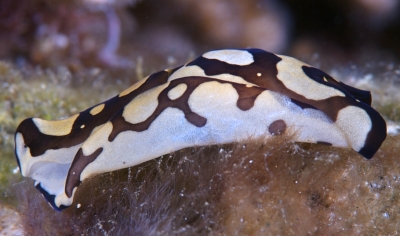
Hi Bill,
One more from Papua New Guinea. This is Philinopsis pilsbryi.
Locality: Dinah's Beach/Lauadi, 10 meters, Milne Bay, PNG, Pacific, 4 April 2007, Sandy bottom with occasional coral. Length: 25 mm. Photographer: Clinton Bauder.
Clinton
gecko1@apple.com
Bauder, C., 2007 (Jul 18) Philinopsis pilsbryi from Milne Bay, PNG. [Message in] Sea Slug Forum. Australian Museum, Sydney. Available from http://www.seaslugforum.net/find/20119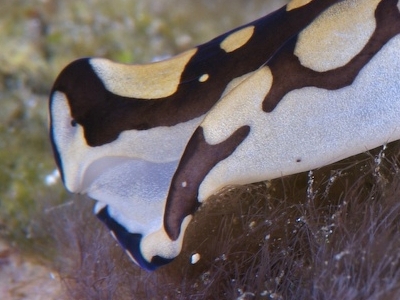
Thanks Clinton,
I have included a close-up alongside to show the very strange head. The large bump at the top is caused by the buccal bulb inside the body which in these aglajids is a long narrow muscular tube, which lies folded up inside the head. I suspect it extends out of the mouth to reach down burrows and cracks to catch its prey [worms? perhaps].
Best wishes,
Bill Rudman
Pink-eyed Philinopsis
March 16, 2006
From: Brian Francisco
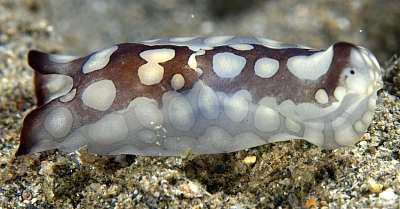
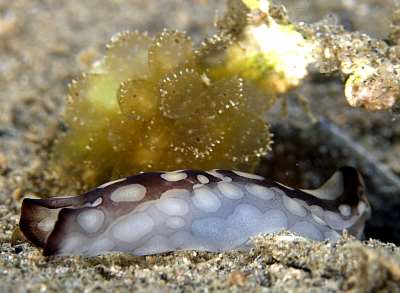
Bill
I'm tempted to say this is Philinopsis pilsbryi, but the patterning is slightly different from other photos I've seen of that species.
Locality: Beach, 17 meters, East Timor, Banda Sea, 22 February 2006, Sandy Bottom. Length: ~3 cm. Photographer: Brian Francisco.
I thought you might grant me a waiver just this once for submitting more than one species in a message; I found this Philinopsis alongside a Cyerce elegans and couldn't resist taking a photo. But what really made this an interesting find were the pink outlines around the eyes of Philinopsis.
Thanks
Brian
francisco.brian@gmail.com
Francisco, B., 2006 (Mar 16) Pink-eyed Philinopsis. [Message in] Sea Slug Forum. Australian Museum, Sydney. Available from http://www.seaslugforum.net/find/16086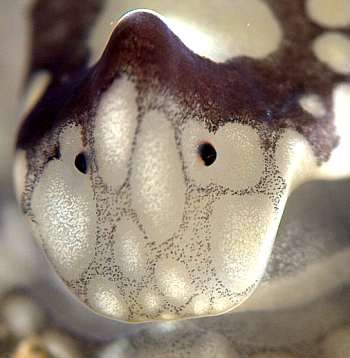
Dear Brian,
This is P. pilsbryi. It is quite variable in colour. I certainly grant you a waiver concerning the Cyerce-like animal which I suspect is Polybranchia orientalis. If you have some other photos of it, it would be a nice record for the Forum, as they are not the easy to photograph showing much detail.
Concerning the pink around the eyes. I don't think I have ever stared so closely at this species before! It is a spectacular photo. With Oren Lederman's photo [#16039] of the head of Chelidonura flavolobata, it's been a good fortnight for aglajids.
Best wishes,
Bill Rudman
Two 'bubble shells' from Indonesia
November 9, 2005
From: Wendy Atkinson
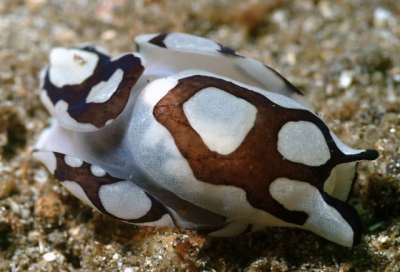
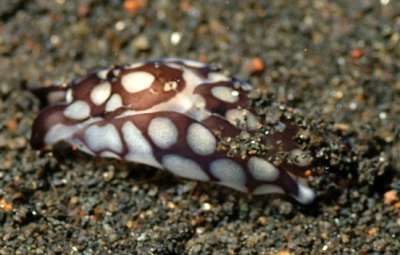
Hi Bill
These were found in Lembeh Strait, Indonesia, May 2005, at Police Pier. Upper photo: 35-40 foot depth, sandy bottom.
Lower photo: 40-60 foot depth, sandy bottom
I'm hoping you can narrow down what types of bubble shells these are. Do you think that they may be variants of the same type?
Thanks in advance,
Wendy Atkinson
billr@seaslugforum.net
Atkinson, W., 2005 (Nov 9) Two 'bubble shells' from Indonesia. [Message in] Sea Slug Forum. Australian Museum, Sydney. Available from http://www.seaslugforum.net/find/15217Dear Wendy,
Yes these are variants of one species. It is Philinopsis pilsbryi.
Best wishes,
Bill Rudman
Philinopsis pilsbryi from Pulau Aur, Malaysia (2)
October 2, 2002
From: Barbara Phua
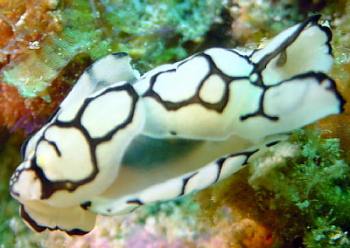
Hi Dr Rudman
Here is another sea slug from Pulau Aur, Malaysia. This is from Captain's Point in Pulau Aur.
Barbara PHUA
babala.pan@pacific.net.sg
Phua, B., 2002 (Oct 2) Philinopsis pilsbryi from Pulau Aur, Malaysia (2). [Message in] Sea Slug Forum. Australian Museum, Sydney. Available from http://www.seaslugforum.net/find/8074Dear Barbara,
This is Philinopsis pilsbryi, which is found throughout the tropical Pacific.
Best wishes,
Bill Rudman
Philinopsis pilsbryi? from the Philippines
June 6, 2001
From: Erwin Koehler
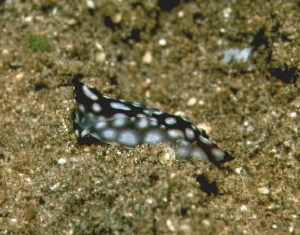
Dear Bill,
Here is a photo of something I would like to call Philinopsis pilsbryi, but it is possibly something else. It is from the Philippines, Negros Oriental Is., depth 10m, size about 2 cm, taken by Georg Heinze
Email: GeorgHeinze@t-online.de
in May 2000
Cheers
Erwin
Erwin@medslugs.de
Koehler, E., 2001 (Jun 6) Philinopsis pilsbryi? from the Philippines. [Message in] Sea Slug Forum. Australian Museum, Sydney. Available from http://www.seaslugforum.net/find/4080Dear Erwin,
I am pretty sure that it is a colour form of P. pilsbryi but perhaps it is best to call it Philinopsis cf. pilsbryi at this stage.
Best wishes,
Bill Rudman
Philinopsis pilsbryi from Hawaii
July 31, 2000
From: Scott Johnson
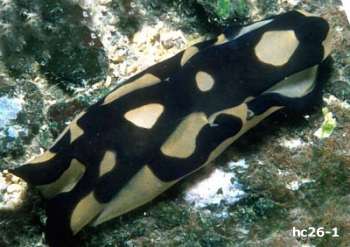
Hi Bill,
Here is a photo of Philinopsis pilsbryi (e182-4) from Hawaii to compare with the photos from the Marshall Ids.
Scott
johnson@kmr.ll.mit.edu
Johnson, S., 2000 (Jul 31) Philinopsis pilsbryi from Hawaii. [Message in] Sea Slug Forum. Australian Museum, Sydney. Available from http://www.seaslugforum.net/find/2794Dear Scott,
Thanks for the photo from Hawaii, and the others from the Marshall Ids.
Certainly the white colour form of Philinopsis reticulata looks very similar to P. pilsbryi, but there is always bluish areas on P. reticulata, especially on the inside edge on the anterior part of the parapodia. Another distinguishing feature, is that in P. reticulata the reticulate pattern is also present on the sole of the foot, while it is usually absent in P. pilsbryi, although there can sometimes be a few black streaks.
This photo from Hawaii, in which the headshield and posterior shield/mantle cavity region, are black with a row of irregular white spots down the dorsal midline, illustrates what is probably the common colour form in Hawaii. This colour form has been named P. alboventralis Bergh, 1897 and Philinopsis nigra, Pease, 1860. The validity of these names is discussed in Rudman,(1972).
Best wishes,
Bill Rudman.
Philinopsis pilsbryi from Marshall Ids
July 31, 2000
From: Scott Johnson
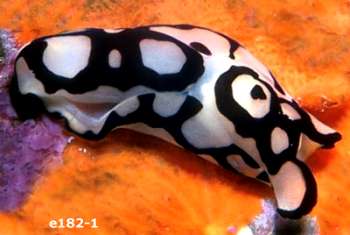
Hi Bill,
Attached are three shots of Philinopsis pilsbryi from the Marshall Ids, for comparison with the Philinopsis reticulata(?) sent earlier.
Scott.
johnson@kmr.ll.mit.edu
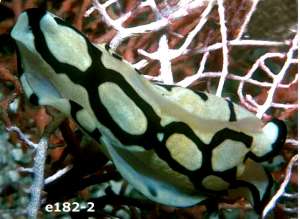
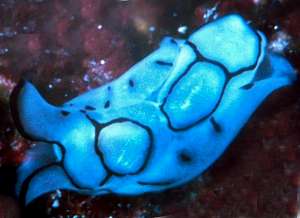
Dear Scott,
Thanks for the photos. I think they are all P pilsbryi. One major difference, is that the reticulate pattern does not continue under the body on to the sole of the foot in this species, as it does in P. reticulata. P. reticulata also has blue patches on the outside of the parapodial edge and on the inside of the parapodial edge at the anterior end.
Best wishes,
Bill Rudman.
